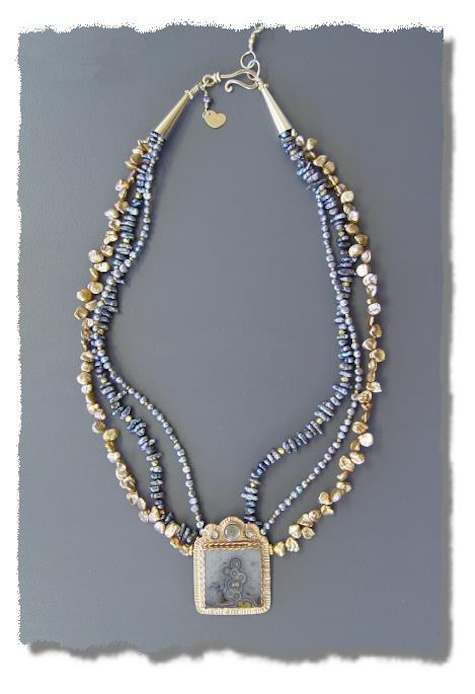Leigh Becker of Eidos managed to find this amazing self portrait of the agate fairy making crazy lace agate! (You can see her better in the enlarged photo.) This is all the more amazing since the back of this little stone is entirely grey with no pattern at all and the front has this amazing image of the fairy with her flying hair summoning the lacy bubbles which give this type of "Bubble Lace Agate" its name. Johann Zenz' definitive Agates lists a great number of names for varieties of crazy lace, and he describes this one as follows: "It's pattern reminds the observer of large, round bubbles. The predominant colors are gray, white and yellow. It occurs in Victor Salgado's former claims." It was Salgado who made lace agate well known all over the world according to Brad Cross.
Indeed, lace agates are arguably the best known agates in the world and are widely represented in collections of beautiful stones.
I put black mother of pearl cabs on the front to carry the bubble theme into the setting, and I put the fairy and more bubbles of citrine and black mother of pearl on the back. Citrine is a silicone dioxide mineral named after the French word for lemon. It is a curious fact that much of the darker citrine on the market today is actually heat-treated amethyst. The Crystal Ally Cards give citrine, one of the fire element allies, the attribute "manifestation," very appropriate for the agate fairy's work! It's curious that I didn't recall this attribute when I designed the piece, I just knew it had to include citrines. The bright stones did not enhance the agate so I put them on the back instead of the front. Now I realize why the fairy wanted them! Ahsian describes how citrine strengthens the second and third chakras, clearing blockages. The third chakra is the chakra of the will and our will can be governed either by our ego or by the "will of the Universe" as she puts it. When it is governed by the ego, she says, we struggle to manifest things that we think will make us feel better, leading to further difficulty. Clearing the third chakra enables us to use it in receiving and manifesting Divine Will. Simmons also talks about citrine's role in activating the sixth chakra. In The Book of Stones, Ahsian distinguishes between natural citrine and the heat-treated variety (which these cabs are) saying the latter carry "lighter energy" and in addition to their third chakra effects, they help "lighten dark thoughts and bring optimism, playfulness and happiness into one's energy systems." Doesn't that describe the mood of the agate fairy in this stone?
The idea that there may be agate fairies is not so far fetched. The Field Guide to the Little People mentions that in Europe there are beings known as Knockers who live in mines and aid the miners they like in finding ore. Miners leave food and clothing for them. Franklin mentions that the name of the best known earth elementals, gnomes, may come from the Greek gnosis ("to know") or ge-nomos ("earth dweller"). My old friend Paracelsus apparently mentioned somewhere that they could move through the earth as a fish through water.
I hope you will give this little fairy a home and let her bring magical manifestations into your life.






